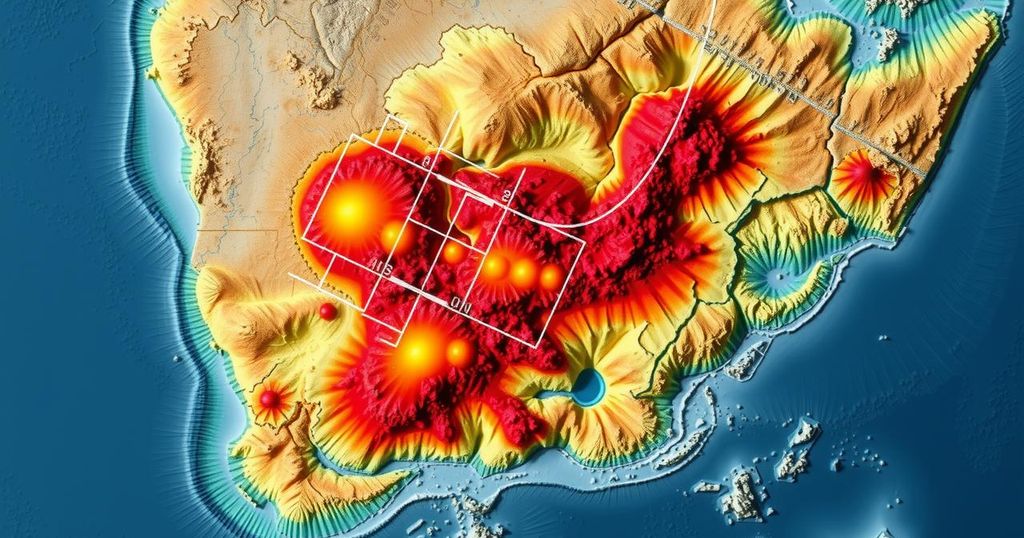A magnitude 5.5 earthquake struck Northern Cape, South Africa, on December 22, awakening residents. The EMSC reported it occurred at a depth of 10 kilometers, with no confirmed damage or injuries. This event raises concerns regarding the seismic risks associated with deep mining activities in the region. Public preparedness is emphasized due to the unpredictable nature of such geological events.
On December 22, a magnitude 5.5 earthquake struck Northern Cape, South Africa, causing residents to awaken due to the unexpected tremors. Reported by the European-Mediterranean Seismological Centre (EMSC), the earthquake occurred at a depth of approximately 10 kilometers, with its epicenter found 120 kilometers northwest of Calvinia. Fortunately, there have been no confirmed reports of injuries or property damage thus far, and inspections are currently underway.
The occurrence of this earthquake is particularly significant for South Africa, a region not typically known for major seismic events. Geologists have noted, “South Africa has never experienced significant quakes, but geologists warn of potential risks due to mining activities increasing at deep levels.” This highlights the delicate balance between local geological stability and human influence, particularly through extensive mining operations that occur at substantial depths, potentially heightening geological stresses and risks for seismic activity.
The incident has catalyzed a wider discourse regarding South Africa’s seismic profile, as historical patterns may underestimate the risks associated with geological events in the area. While mining plays a crucial role in South Africa’s economic framework, the implications of increased subterranean excavations on geological stability require careful consideration to mitigate potential seismic repercussions.
Although the earthquake did not result in any significant damages, it serves as a reminder of the precariousness associated with living in an area susceptible to seismic activity. A local safety official remarked, “Our lives can change dramatically with just one tremor, and being prepared is our best defense, whether we live where earthquakes are common or where they are rare,” reinforcing the necessity for public readiness and awareness.
As assessments are conducted by authorities to evaluate any potential damage, residents are advised to remain vigilant for possible aftershocks, which commonly follow such seismic events. The EMSC continues to monitor the situation, providing crucial updates regarding the earthquake’s impact and future risks. For those residing near the epicenter, this earthquake is a pertinent reminder of the inherent unpredictability of geological events and the importance of preparedness in facing such challenges.
While this event may qualify as moderate in strength, the geological threats associated with deep mining endeavors remain a pressing concern, warranting ongoing scrutiny. Geologists and safety officials are actively collaborating to ascertain the extent of any damage and determine possible future seismic activities. This earthquake, though not resulting in casualties, underscores the vital need for a comprehensive approach to natural disaster preparedness in South Africa.
The seismic history of South Africa does not typically include significant earthquake activity, making the recent 5.5 magnitude tremor notable. As industrialization and mining activities expand, particularly at great depths, the potential for geological instability has increased. Geologists emphasize the importance of understanding and preparing for seismic risks, particularly in light of human influence on geological conditions. The country’s economy heavily relies on mining, raising concerns regarding safety and preparedness in the event of unexpected seismic activity.
The earthquake in Northern Cape serves as a critical reminder of the unpredictability of geological events, emphasizing the need for heightened awareness and preparedness among residents. While the lack of immediate damages is reassuring, the potential effects of mining activities on geological stability must be continually evaluated. South Africa must consider the risks posed by seismic activity more seriously and proceed with necessary caution to mitigate future hazards associated with both natural and human-induced geological changes. Collaboration between geological agencies and safety officials will be paramount in understanding and addressing the implications of the recent earthquake, as residents are advised to remain informed and prepared for possible aftershocks.
Original Source: evrimagaci.org






